Henny Porten and the young and handsome Paul Hartmann were the stars of the Messter film drama Monika Vogelsang (Rudolf Biebrach, 1920).

German collectors card by Ross Verlag in the series Vom Werden deutscher Filmkunst - Der Stumme Film, picture, picture no. 81, group 43. Photo: Ufa. Publicity still for Monika Vogelsang (Rudolf Biebrach, 1920) with Henny Porten and Paul Hartmann.
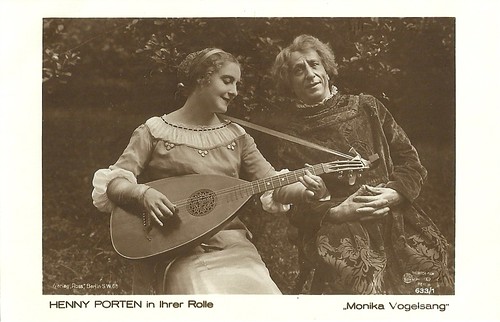
German postcard by Ross Verlag, no. 633/1. Photo: Messter Film, Berlin. Publicity still for Henny Porten and Gustav Botz [?] in Monika Vogelsang (Rudolf Biebrach, 1920).
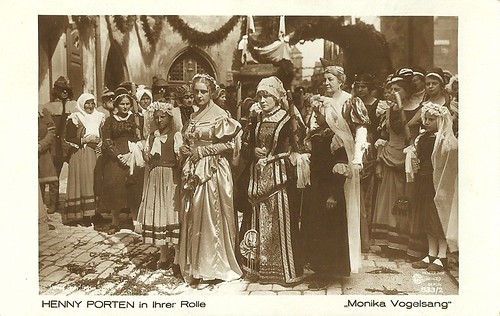
German postcard by Ross Verlag, no. 633/2. Photo: Messter Film, Berlin. Publicity still for Henny Porten in Monika Vogelsang (Rudolf Biebrach, 1920).
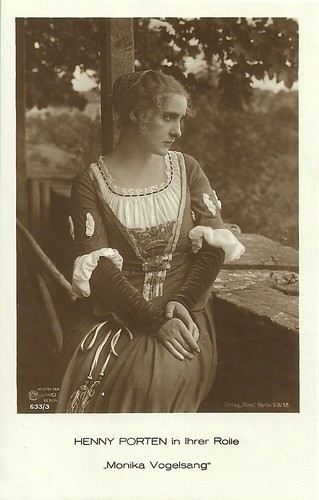
German postcard by Ross Verlag, no. 633/3. Photo: Messter Film, Berlin. Publicity still for Henny Porten in Monika Vogelsang (Rudolf Biebrach, 1920).
One day, Monica Vogelsang (Henny Porten), daughter of the reputed counsellor Jacobus Vogelsang (Gustav Botz), meets the visiting painter Amadeo Vaselli (Paul Hartmann) and immediately falls in love with him.
But Amadeo is rivalled by the idle Johannes (Ernst Deutsch), working for Vogelsang, and eyeing young Monica for some time. When he is rejected by Monika he avenges himself by gossipping about her, making evil remarks and hints. He tries to eliminate his opponent, but in a fight Amadeo stabs John.
Amadeo is arrested and admits his deed. To save his neck, Monica claims that Amadeo had been with her the questionable night, but Amadeo sticks to his confession and is condemned to death by the rope. His last wish to just see Monica once more is granted. So shortly before his execution, Monica faces him one last time, while covered in a veil.
Monica breaks down. When the veil is lifted, one notices her hair has become white. After Amadeo's execution, Monica erects a chapel in his honour. She descends to his grave and slides down to the ground, mentally crushed. Later, Amadeo is rehabilitated by the Archbishop (Wilhelm Diegelmann).
Monika Vogelsang, based on the novel by Felix Philippi and scripted by Hans Kräly, was shot in 1919 but premiered on 2 January 1920 in Berlin. Exteriors were shot in Rothenburg ob der Tauber, Bavaria, Germany. Sets were designed by Kurt Dürnhöfer.
Oskar Kalbus in Vom Werden deutscher Filmkunst. 1. Der stumme Film (Berlin, 1935): "With this film, we are transferred to the heroic period of the Renaissance with its passions that extend into the bourgeoisie. A masterpiece of character representation was how Henny Porten's meek-naive childishness develops into active heroism."
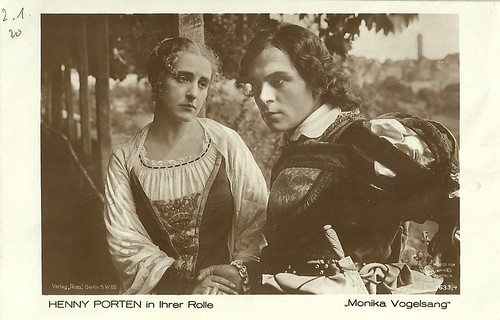
German postcard by Ross Verlag, no. 633/4. Photo: Messter Film, Berlin. Publicity still for Henny Porten and Paul Hartmann in Monika Vogelsang (Rudolf Biebrach, 1920).
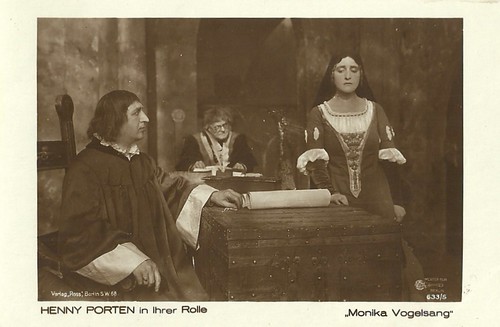
German postcard by Ross Verlag, no. 633/5. Photo: Messter Film, Berlin. Publicity still for Henny Porten in Monika Vogelsang (Rudolf Biebrach, 1920).
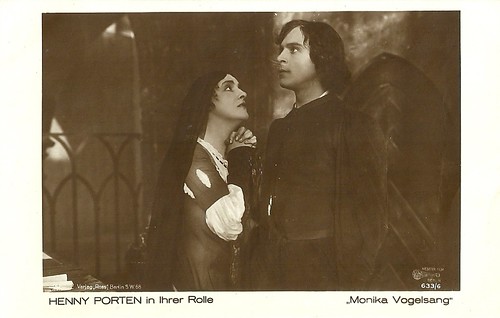
German postcard by Ross Verlag, no. 633/6. Photo: Messter Film, Berlin. Publicity still still of Henny Porten and Paul Hartmann in Monika Vogelsang (Rudolf Biebrach, 1920).
Sources: Wikipedia (German) and IMDb.

German collectors card by Ross Verlag in the series Vom Werden deutscher Filmkunst - Der Stumme Film, picture, picture no. 81, group 43. Photo: Ufa. Publicity still for Monika Vogelsang (Rudolf Biebrach, 1920) with Henny Porten and Paul Hartmann.

German postcard by Ross Verlag, no. 633/1. Photo: Messter Film, Berlin. Publicity still for Henny Porten and Gustav Botz [?] in Monika Vogelsang (Rudolf Biebrach, 1920).

German postcard by Ross Verlag, no. 633/2. Photo: Messter Film, Berlin. Publicity still for Henny Porten in Monika Vogelsang (Rudolf Biebrach, 1920).

German postcard by Ross Verlag, no. 633/3. Photo: Messter Film, Berlin. Publicity still for Henny Porten in Monika Vogelsang (Rudolf Biebrach, 1920).
A masterpiece of character representation
One day, Monica Vogelsang (Henny Porten), daughter of the reputed counsellor Jacobus Vogelsang (Gustav Botz), meets the visiting painter Amadeo Vaselli (Paul Hartmann) and immediately falls in love with him.
But Amadeo is rivalled by the idle Johannes (Ernst Deutsch), working for Vogelsang, and eyeing young Monica for some time. When he is rejected by Monika he avenges himself by gossipping about her, making evil remarks and hints. He tries to eliminate his opponent, but in a fight Amadeo stabs John.
Amadeo is arrested and admits his deed. To save his neck, Monica claims that Amadeo had been with her the questionable night, but Amadeo sticks to his confession and is condemned to death by the rope. His last wish to just see Monica once more is granted. So shortly before his execution, Monica faces him one last time, while covered in a veil.
Monica breaks down. When the veil is lifted, one notices her hair has become white. After Amadeo's execution, Monica erects a chapel in his honour. She descends to his grave and slides down to the ground, mentally crushed. Later, Amadeo is rehabilitated by the Archbishop (Wilhelm Diegelmann).
Monika Vogelsang, based on the novel by Felix Philippi and scripted by Hans Kräly, was shot in 1919 but premiered on 2 January 1920 in Berlin. Exteriors were shot in Rothenburg ob der Tauber, Bavaria, Germany. Sets were designed by Kurt Dürnhöfer.
Oskar Kalbus in Vom Werden deutscher Filmkunst. 1. Der stumme Film (Berlin, 1935): "With this film, we are transferred to the heroic period of the Renaissance with its passions that extend into the bourgeoisie. A masterpiece of character representation was how Henny Porten's meek-naive childishness develops into active heroism."

German postcard by Ross Verlag, no. 633/4. Photo: Messter Film, Berlin. Publicity still for Henny Porten and Paul Hartmann in Monika Vogelsang (Rudolf Biebrach, 1920).

German postcard by Ross Verlag, no. 633/5. Photo: Messter Film, Berlin. Publicity still for Henny Porten in Monika Vogelsang (Rudolf Biebrach, 1920).

German postcard by Ross Verlag, no. 633/6. Photo: Messter Film, Berlin. Publicity still still of Henny Porten and Paul Hartmann in Monika Vogelsang (Rudolf Biebrach, 1920).
Sources: Wikipedia (German) and IMDb.
No comments:
Post a Comment